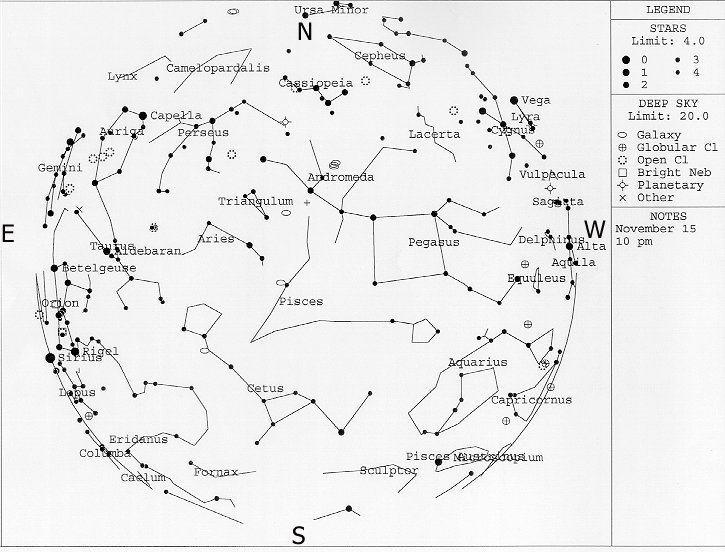What's to see in the night sky in November?

This chart represents the sky as it looks at around 10 PM local
time. Some adjustment should be made for longitude, but it shouldn't be much. Right click on
the chart, select "Save As" and save the image. You can then print
this chart from a photo application, like Print Shop Pro, hold it in front of you with the
direction you are facing at the bottom. Then, raise it above your head and you should be
able to find your way around from there.
Alert! Leonid Meteor Shower Peaks On 11/17/07!
Moon phases
New-11/9_____First Quarter-11/17____Full-11/24____Last Quarter-11/1
Planets
Mercury .
Venus
Mars
Jupiter .
Saturn
Meteor showers
November of course, means the Leonids! Active from 11/14-11/21, peaking on the
17th, every year we're promised a possible "meteor storm", but somehow here in the states we
manage to miss it. I make no predictions here, but I think it's our turn this year. :-) Even
if it doesn't work out, there's always a bunch of them suckers anyway. I'll be outside on the
17th at any rate. Care to join me?
Deep Sky Objects (DSO's)
Messier Objects
PN-M76-the Little Dumbell is small and resembles the big Dumbell I guess, but it's still
really small.. OC-M103 is small, but bright. Galaxies-M31, 32, 33, 74 and 110.
M31, 32 and 110 are all associated as the Great Andromeda Galaxy. Amazing to think that
when the
light you see left them, Homo Sapiens was just getting started in Africa. (I know, I know, but
that's the way I learned it, nonetheless.)
M33 in Triangulum and M74 in Pisces are
two of the
closest, largest, lowest surface brightness galaxies around. Can be frustrating, even when
located. "Is that really all it is? Shouldn't I be able to see more detail? After all, it's
HUGE on the charts..." Now you know what low surface brightness means.
Named DSO's
Although there aren't any "named" DSO's here, there are several very nice DSO's. First
should be NGC 253 in Sculptor. Find Diphda in Cetus, it's the bottom star in the faint
trianglular asterism to the west of the constellation. Go south and just a little east-you
can see this big, bright, edge-on galaxy in binoculars.
A little east and south of 253 is globular NGC 288. Big and loose, it's easy to see, if
your skies are dark and your horizon is low.
A little farther north is the PN NGC 246. Almost smack in the middle of the triangle
asterism I mentioned earlier. Happy hunting!
Here's the link to SEDS as promised.
| January's page | February's page | March's's page | April's page | May's page | June's page |
| July's page | August's page | September's page | October's page | November's page | December's page |

Copyright 1999, Steve Dodder
Webmaster: Steve Dodder
Revised: 5/15/00
